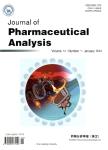Regulation of drug release performance using mixed doxorubicin-doxorubicin dimer nanoparticles as a pH-triggered drug self-delivery system
Regulation of drug release performance using mixed doxorubicin-doxorubicin dimer nanoparticles as a pH-triggered drug self-delivery system作者机构:State Key Laboratory of Applied Organic ChemistryCollege of Chemistry and Chemical EngineeringLanzhou UniversityLanzhou730000China
出 版 物:《Journal of Pharmaceutical Analysis》 (药物分析学报(英文版))
年 卷 期:2022年第12卷第1期
页 面:122-128页
核心收录:
学科分类:100702[医学-药剂学] 1007[医学-药学(可授医学、理学学位)] 1006[医学-中西医结合] 100602[医学-中西医结合临床] 10[医学]
主 题:Drug self-delivery system Regulated drug release Doxorubicin-doxorubicin dimer Acid-triggered release Mixed nanoparticles
摘 要:A mixed drug self-delivery system(DSDS)with high drug content(50%)was developed to regulate pHtriggered drug release,based on two doxorubicin(DOX)-DOX dimmers:D-DOX_(ADH) and D-DOX_(car) conjugated with acid-labile dynamic covalent bonds(hydrazone and carbamate,respectively)and stabilized with PEGylated D-DOX_(ADH)(D-DOX_(ADH)-PEG).Owing to the different stability of the dynamic covalent bonds in the two dimers and the noncovalent interaction between them,pH-triggered drug release could be easily regulated by adjusting the feeding ratios of the two DOX-DOX dimers in the mixed *** in vitro cellular toxicity was achieved with the mixed DSDS nanoparticles prepared with different feeding *** mixed DSDS nanoparticles had a similar DOX content and diameter but different drug releasing *** MTT assays revealed that a high anti-tumor efficacy could be achieved with the slowrelease mixed DSDS nanoparticles.



